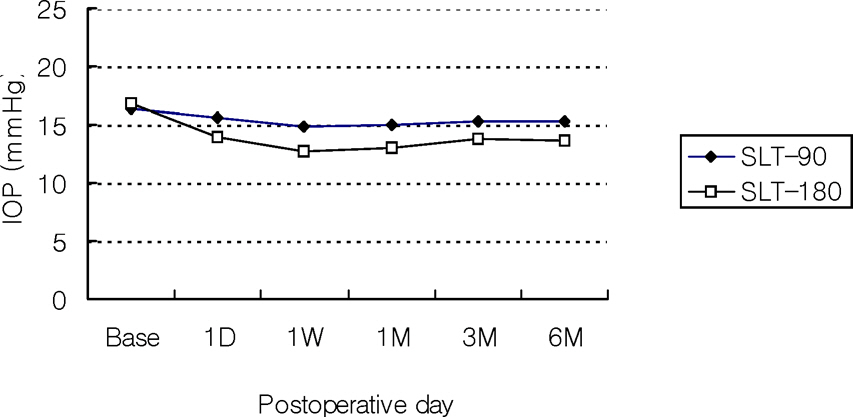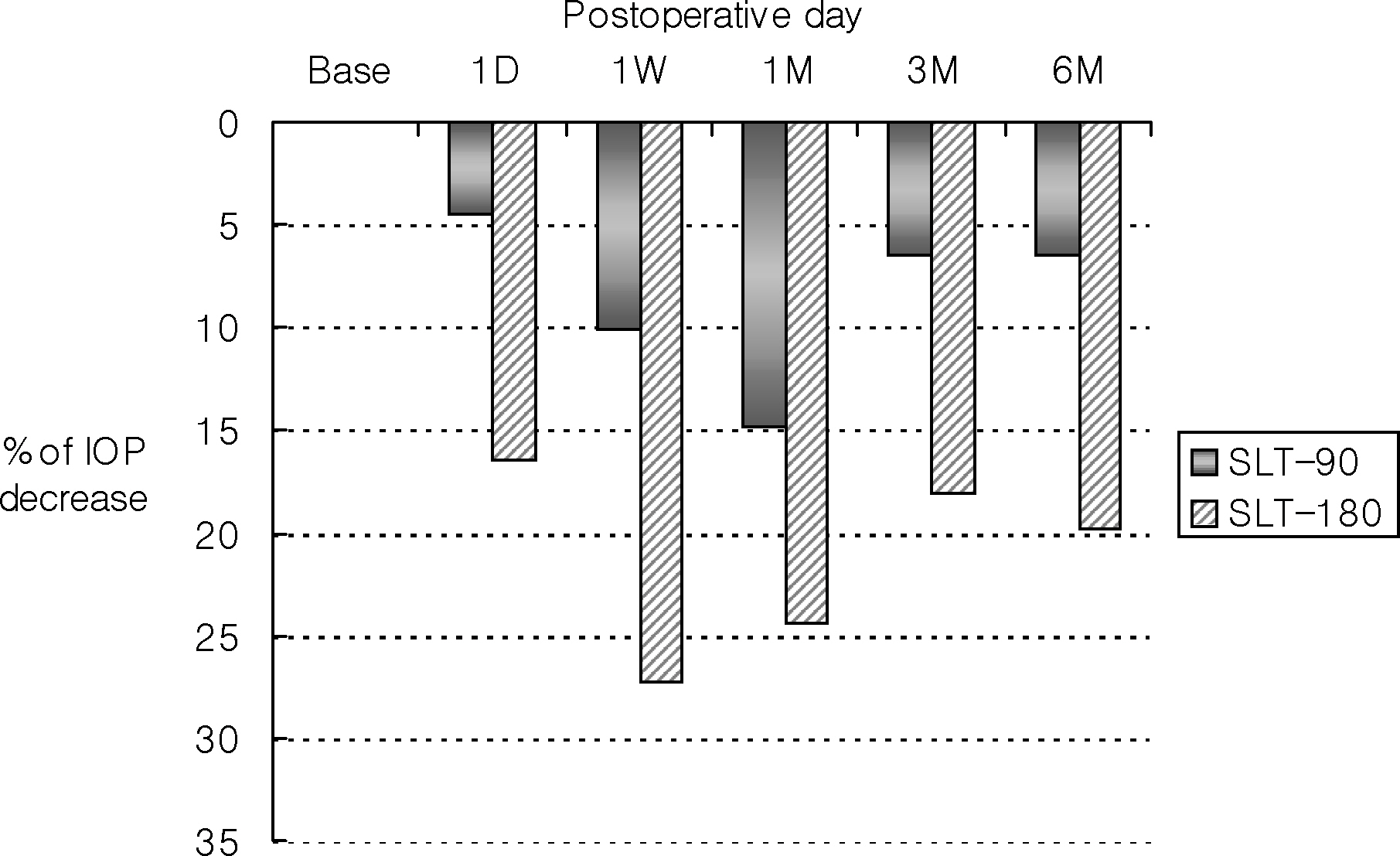J Korean Ophthalmol Soc.
2007 Nov;48(11):1500-1505.
A Comparison of Efficacy and Safety Between 90 degrees and 180 degrees Selective Laser Trabeculoplasty
- Affiliations
-
- 1Department of Ophthalmology, College of Medicine, The Catholic University of Korea, Seoul, Korea. jimoon@catholic.ac.kr
Abstract
-
PURPOSE: To compare the intraocular pressure-lowering effect and safety between 180 degrees and 90 degrees selective laser trabeculoplasty (SLT).
METHODS
From January 2006 to august 2006, in patients with primary open-angle glaucoma and ocular hypertension, SLT was performed 90 degrees to the right eye and 180 degrees to the left eye within the same patient. Intraocular pressure was checked at 1 hour, 1 day, 1 week, 1 month, 3 months, and 6 months after SLT. Anterior chamber reaction and ocular pain was checked at postoperative 1 day. Peripheral anterior synechia was examined at 6 months postoperatively.
RESULTS
Fourteen patients (28 eyes) of primary open-angle glaucoma and two patients (4 eyes) of ocular hypertension were included. There was no difference of intraocular pressure between 180 degrees group and 90 degrees group preoperatively. However, there were statistically significant differences from postoperative 1 hour (p=0.003), through 1 week (15.6+/-2.3 mmHg in 90 degrees group, 14.0+/-2.5 mmHg in 180 degrees group; p=0.000), to 6 months (p=0.001). Thirty-two percent of the 90 degrees group and Seventy-five percent of the 180 degrees group showed successful intraocular pressure decrease. There was a slightly higher complication rate of anterior chamber reactions and transient intraocular pressure spikes in the 180 degrees group.
CONCLUSIONS
Performing 180 degrees SLT seems the safest procedure that guarantees the successful intraocular pressure decrease.
Keyword
MeSH Terms
Figure
Reference
-
References
1. Latina MA, Park C. Selective targeting of trabecular meshwork cells: in vitro studies of pulsed and CW laser interactions. Exp Eye Res. 1995; 60:359–72.
Article2. Latina MA, Sibayan SA, Shin DH, et al. Q-switched 532-nm Nd:YAG laser trabeculoplasty (selective laser trabeculoplasty): a multicenter, pilot, clinical study. Ophthalmology. 1998; 105:2082–8.3. Kramer TR, Noecker RJ. Comparison of the morphologic changes after selective laser trabeculoplasty and argon laser trabeculoplasty in human eye bank eyes. Ophthalmology. 2001; 108:773–9.
Article4. Latina MA, DeLeon JM. Selective laser trabeculoplasty. Ophthalmol Clin North Am. 2005; 18:409–19.
Article5. Stein JD, Challa P. Mechanisms of action and efficacy of argon laser trabeculoplasty and selective laser trabeculoplasty. Curr Opin Ophthalmol. 2007; 18:140–5.
Article6. Jurych MS, Chopra V, Banitt MR, et al. Comparison of long-term outcomes of selective laser trabeculoplasty versus argon laser trabeculoplasty in open-angle glaucoma. Ophthalmology. 2004; 111:1853–9.
Article7. Weinand FS, Althen F. Long-term clinical results of selective laser trabeculoplasty in the treatment of primary open angle glaucoma. Eur J Ophthalmol. 2006; 16:100–4.
Article8. Lai JS, Chua JK, Tham CC, Lam DS. Five-year follow up of selective laser trabeculoplasty in Chinese eyes. Clin Experiment Ophthalmol. 2004; 32:368–72.
Article9. Martinez-de-la-Casa JM, Garcia-Feijoo J, Castillo A, et al. Selective vs argon laser trabeculoplasty: hypotensive efficacy, anterior chamber inflammation, and postoperative pain. Eye. 2004; 18:498–502.
Article10. Kajiya S, Hayakawa K, Sawaguchi S. Clinical results of selective laser trabeculoplasty. Jpn J Ophthalmol. 2000; 104:160–4.
Article11. Kim JS, Lee YG, Hong YJ. Q-switched, frequency doubled Nd:YAG laser trabeculoplasty. J Korean Ophthalmol Soc. 1999; 40:2591–6.12. Lee HY, Baek NH, Moon JI. Comparison of short-term outcomes of argon laser versus selective laser trabeculoplasty in open-angle glaucoma. J Korean Ophthalmol Soc. 2005; 46:2004–9.13. Suhk HJ, Kook MS. Three year follow up of laser trabeculoplasty using Q-switched frequency doubled Nd:YAG laser. J Korean Ophthalmol Soc. 2003; 44:93–9.14. Chen E, Golchin S, Blomdahl S. A comparison between 90° and 180° selective laser trabeculoplasty. J Glaucoma. 2004; 13:62–5.
Article15. Song J, Lee PP, Epstein DL, et al. High failure rate associated with 180° selective laser trabeculoplasty. J Glaucoma. 2005; 14:400–8.
Article16. McIlraith I, Strasfeld M, Colev G, Hutnik CM. Selective laser trabeculoplasty as initial and adjunctive treatment for open-angle glaucoma. J Glaucoma. 2006; 15:124–30.
Article
- Full Text Links
- Actions
-
Cited
- CITED
-
- Close
- Share
- Similar articles
-
- Comparison of Efficacy and Safety between Superior 180 Degree and Inferior 180 Degree Selective Laser Trabeculoplasty
- Comparison of Short-term Outcomes of Argon Laser versus Selective Laser Trabeculoplasty in Open-Angle Glaucoma
- Comparison of Clinical Outcomes of Argon Laser Versus Selective Laser Trabeculoplasty in POAG
- Two-year Follow-up of Selective Laser Trabeculoplasty as Initial and Adjunctive Treatment for Ocular Hypertension and Open Angle Glaucoma
- Short-Term Clinical Outcomes of Laser Trabeculoplasty Using a 577-nm Wavelength Laser



